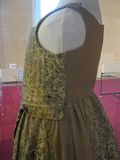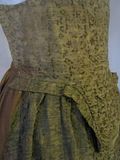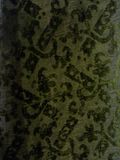THE GREEN PISA DRESS
Another poorly translated bit on the Pisa dresses; this time the green/golden velvet dress.





Sixteenth century, the last two decades (I would personally have guessed early 17th century). Fabric weave of cut velvet of green silk and yellow laminated gold threads, and lined with unbleached linen, yellow taffeta and green felt ("Confezionato in velluto tagliato operato a un corpo in seta verde su fondo giallo laminato in oro; fodera in tela di lino naturale e taffetas giallo; pedana in feltro verde.")
The bodice has a center seam in front, a square neckline and straps which pass the top of the shoulder, and a rounded belly going down in a sort of small apron slightly enriched (basque?); closed right beyond the natural line of the sides with eight lacing holes on each side.
Large linen bands was going in cross from strap to strap, and in the waist of the bodice (to tie it together after the back bodice was removed). Traces of spun gold and lamellar are visible on the side of a slot at the bodice.
The bodice is lined with natural linen with some parts in yellow taffeta. The skirt is slightly longer in the back, made of four panels with side gussets and front center seam. Waist slightly curved, almost flat on the front; edges internally reinforced with green felt band.
The fabric is brittle and dehydrated with large yellow streaks of moisture mark in the fabric at the waist and along the edge. Orthogonal splits and cuts open the bottom of the fabric along the lines of the drapery. The metal threads, blackened because of oxidation, is raised and broken in several places.
Many gaps due to the action of moths are visible on the felt reinforcements. The dress is missing the back of the bodice, and the skirt was heavily remodeled leaving a gap in the back. The train was almost eliminated by unstitching and moving up the panels of the rear skirt, the excess tissue that has arisen in waist was used to close the back and close the front bodice seams front extensions (? "...e fermata al bustino anteriore con cuciture posticce"). This adjustment resulted in the elimination of the sleeves carefully fastened with clasp at sewing (...accuratamente tamponati con fermature a cucito...") which indicated that the dress was redone to fit a statue without arms.
Because of the fragility of the fabrics, the dress was put between two layers of tulle protecting it during the cleaning with a dusting brush. A partial rehydration of the fiber was obtained by laying the garment on a large frame made of soft polyester mesh, which allowed to gently spray it with mist humidifier on both sides of the fabric.
Freed from the armhole seam the fabric of the skirt was sewn on consolidated total support in yellow taffeta (Liberati a giri manica dalle cuciture il tessuto della gonna); a netting of transparent polyester were permanently applied on the back side of the cloth to protect the areas damaged.
This technique stabilized and supported the various materials, ensuring a vertical display clothing (I.E. made them able to display them on a mannequin instead of laying down).
The measurements of the front bodice made them able to reconstruct a hypotetical back bodice, and the back of the skirt rebalanced the waist was solved by folds in the internal distribution of points is kept (huh? Don't get this one... Il posizionamendo su un busto su misura ha guidato le fasi conclusive del restauro concentendo il corretto posizionamendo del dietro della gonna: riequilibrata la punto vita è stata risolta con pieghe interne distribuite nei punti di maggior tenuta).
To support the weight of the dress, a yellow bodice taffeta identical to the original was made, slightly undersized in the front. The bodice has velcro in the waist band to hold up the velvet skirt. With this type of substructure the weight and wear of the dress is distributed and minimized.
(Original text by conservator Moira Brunori)
MY NOTE: the restoring team has unpicked the remodelled skirt and placed the panels back to where they probably originally was. Some parts had been removed from the side skirt; this area is today substituted with a plain green/yellow fabric. Same fabric is used for the missing back bodice. This dress originally had sleeves, as they've found traces of sleeve fastening on the shoulders/arm hole. I think the dating is a bit early; that kind of front bodice screams Baroque to me. But lots of research on these dresses have been done since the book I'm translating from, so I'm thinking it was an early assumption based on the similar features to the two other dresses. Or I might be wrong... Most Tuscan portraits from the late 16th century either shows domestic dresses like the blue/grey one I previously posted about, or substructures hidden by overdresses. Some of them might hide a bodice similar to the green/golden one.